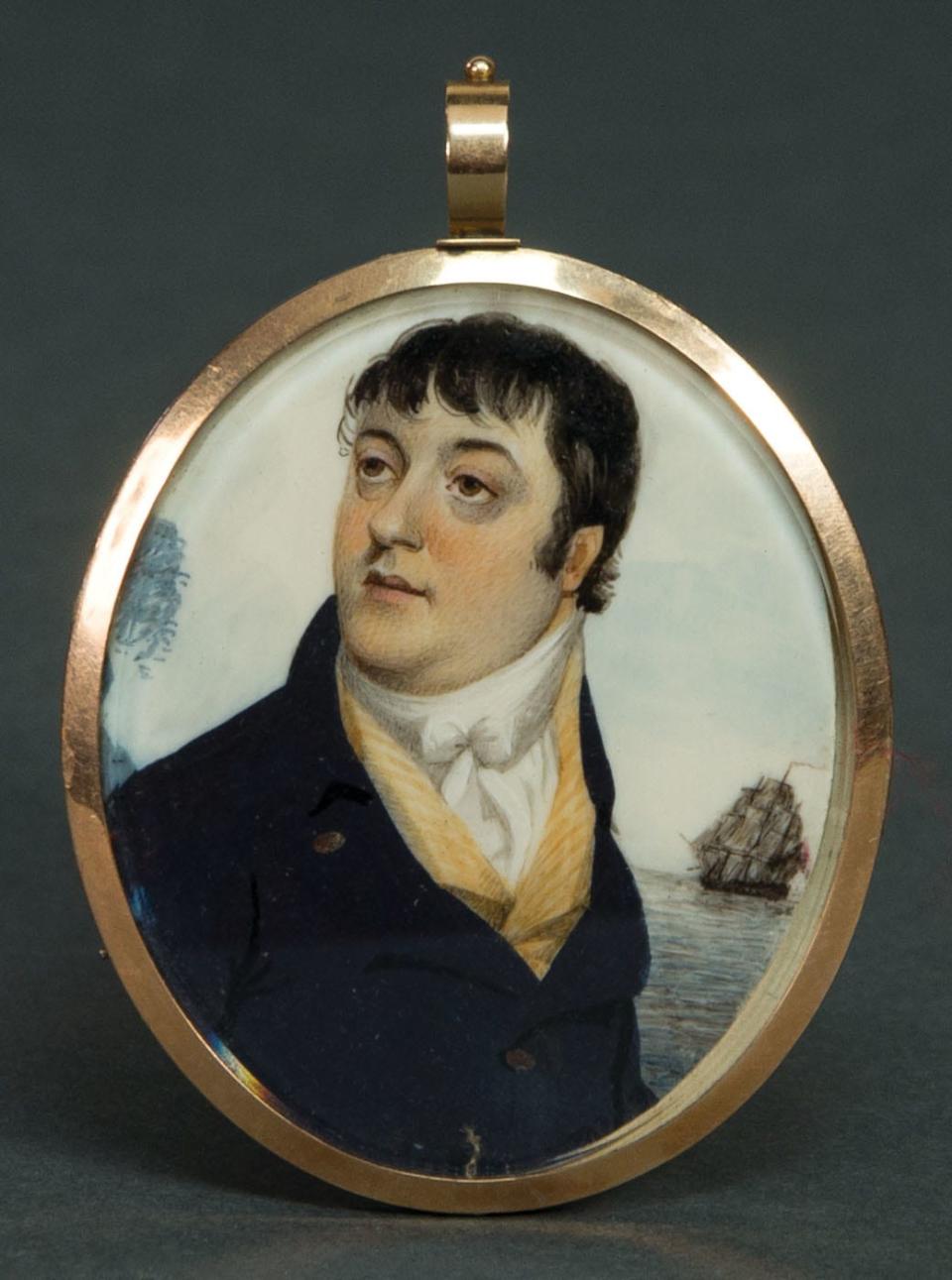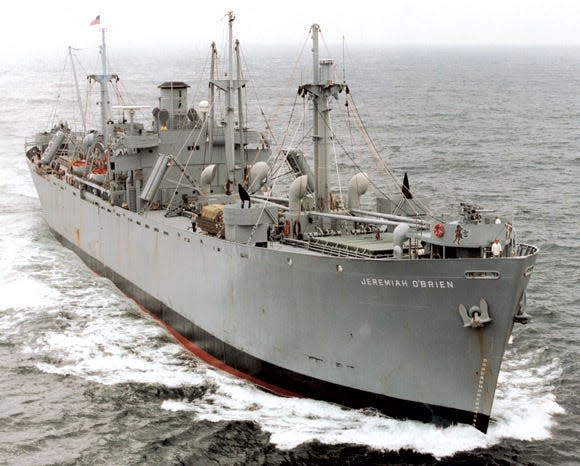Meet Kittery's Jeremiah O'Brien, America's first naval hero of the Revolutionary War
You can’t blame an old-school Navy town like Kittery − where his first warship the Ranger was built − for hyping any connection to the legendary Father of the American Navy, John Paul Jones.
But the first American naval hero of the Revolutionary War, it turns out, was actually a Kittery native. And I frankly have no idea why Jeremiah O’Brien isn’t a household name today, not only in Maine classrooms but all across the country.

The United States Navy has named no less than five ships after O’Brien over the past couple of centuries, including the World War II destroyer USS O’Brien (DD 214) which was sunk by the Japanese in 1942. In addition, the World War II Liberty ship SS Jeremiah O'Brien, manned by members of the Merchant Marine to carry wartime cargo, still operates today in San Francisco as a living museum.

A Maine state park up in Machias is named for O’Brien, and every June, that town commemorates what is considered America’s first navy victory of the Revolutionary War with its annual Margaretta Days Festival. The event is named after the British ship taken during the battle − described by famed 19th-century novelist James Fenimore Cooper as “the Lexington of the Sea” – by townsmen wielding pitchforks and axes.
This engagement is also considered the birth of the United States Merchant Marine. And yet, it’s a pretty safe bet most average Americans outside of Maine (and a disappointing number of current residents) are not familiar with the exploits of this colorful character. I have to admit, I only learned of O’Brien’s heroism from Raymond Faulkner, a local Coast Guard veteran and history buff employed at Piscataqua Savings Bank.
Jeremiah was the oldest of six brothers, all born to Irish immigrant Morris O’Brien and his Kittery-born wife Mary, who gave birth to Jeremiah in Kittery around 1740. According to Rev. Andrew M. Sherman’s 1902 biography “Life of Captain Jeremiah O’Brien,” the clan later relocated to Scarborough before finally settling in Machias around 1766 to establish a lumber mill.
It was in this Down East seaport where the battling O’Brien brothers, led by Jeremiah, would establish their notoriety. And now, having taken the time to dig just a little into their escapades, my burning question is: Why isn’t this story already an HBO mini-series?
Maine genealogist/historian and Machias resident Valdine Atwood says Jeremiah was a “bigger-than-life individual.”
“He was a hot-headed Irishman,” she said recently. “He was a smart fellow but he was quite a character.”
To give an example, Atwood says Sherman, the Methodist minister who wrote the definitive biography of Jeremiah O’Brien, was the son of O’Brien’s illegitimate daughter – a fact the reverend never mentioned in his nearly 340-page volume.
Although no known documentation has yet turned up, Atwood says genealogists believe Morris and Mary O’Brien were married here in Kittery. Morris is said to have been born in Dublin. Their three oldest children were born here as well – Jeremiah and his sisters Martha and Joanna. Over the years, the family would be joined by brothers Gideon, John, William, Dennis and Joseph, as well as another sister, Mary.
Jeremiah was a born leader, according to his grandson Sherman’s glowing descriptions:
“He could swing a woodman’s axe; raft the prostrate timber through the river to the mills; transform the rough logs into marketable lumber; throw a contestant in a friendly wrestling match, or drive a shrewd bargain for the disposition of lumber with the master of a coasting vessel, with equal ease; and yet Jeremiah O’Brien was neither bully nor brawler nor miser, but a young man of ‘excellent character.’”
But Atwood points out that the town clerk of Machias, Jonathan Longfellow, once brought Jeremiah to court for throwing him to the ground and “beating him up.”
Still, his fighting spirit apparently made Jeremiah the right man in the right place when the events culminating in the Battle of Machias – also known as the Battle of the Margaretta – transpired in June 1775.
The most popular story associated with this incident starts with a liberty pole erected in the middle of town following the bloody events of Lexington and Concord in April 1775. Liberty poles were installed throughout the Colonies around this time to represent support for the patriotic cause against British tyranny. Machias is even today a four-hour drive from Maine’s southern border, but talk of independence eventually reached this small frontier town and its residents wanted to display their patriotism.
In early June, the British warship HMS Margaretta accompanied two merchant vessels carrying much-needed provisions to the northern seaport, with the goal of returning to Boston with timber required to build barracks for the King’s troops there. As the story goes, the British skipper, a young midshipman named James Moore, ordered the liberty pole to be taken down, “or it will be my painful duty to fire upon the town."
The good people of Machias held more than one town meeting to decide the matter, and ultimately decided not only to leave the pole intact but to seize the British skipper Moore, and the local merchant representing the Crown, and the Margaretta herself.
Moore managed to escape to his ship and head downriver. However, one O’Brien’s youngest brothers, Dennis, joined a couple of his friends in seizing the Unity, one of the merchant ships that had arrived from Boston. Jeremiah was among nearly three dozen men – including all the O’Brien boys – who then set out in pursuit of the British ship on June 12th. Legend has it old Morris, the 60-year-old patriarch of the O’Brien clan, had to be dissuaded from heading out as well.
The colonists literally wielded axes and pitchforks, along with some rifles, in their effort to capture this vessel of the world’s mightiest Navy. Jeremiah was quickly and unanimously chosen from the ranks to serve as captain. He then permitted some of the more faint-hearted townsmen to row to shore in a small boat before engaging with the enemy.
“Now, my brave fellows, having got rid of those white-livered cowards, our first business will be to get alongside of the schooner yonder,” Jeremiah reportedly roared, “and the first man who boards her shall be entitled to the palm of honor.”
As it turns out, that man turned out to be his feisty brother John, who found himself on the deck of the Margaretta when the ships closed quarters – and all alone against the British crew when the vessels suddenly broke apart. John promptly jumped overboard to avoid enemy bayonets and had to be fished out by his fellow patriots.
Eventually the two ships came close enough for Jeremiah to have his crew lash the vessels together, and then lead a boarding party of men brandishing their pitchforks and other weapons.
The unfortunate young British officer Moore was killed by gunfire during the exchange, prompting the British surrender. According to Sherman, it was Jeremiah himself who hauled down the ensign of the enemy ship, bringing him the honor of being the first colonist to claim a British flag during the war.
“This affair was the Lexington of the sea,” Cooper, author of such adventure classics as “The Last of the Mohicans,” wrote in an 1839 Navy history, “for like that celebrated land conflict, it was a rising of the people against a regular force, was characterized by a long chase, a bloody struggle, and a triumph.”
Recounting all of O’Brien’s escapades during the war would require a heck of a lot more space than available here, but they truly deserve big-screen treatment.
The very next month after O’Brien’s victory over the Margaretta, the British sent two more warships – the Diligent and the Tapnaquish -- after the irascible Irish-American. The guns of the Margaretta had been transferred to the Unity – which became the Machias Liberty – and on July 12th, he and fellow Machias captain Benjamin Foster instead captured both of these vessels as well.
“The exploits of Capt. O'Brien stirred up seamen from Maine to the Carolinas, and luckless indeed was the British vessel that fell into their clutches,” historian Willis J. Abbott wrote in his 1890 “Naval History of the United States.”
O’Brien continued on as a privateer, a sort of legalized pirate authorized to capture enemy merchant ships. Sometime around 1780, he was himself taken prisoner off the coast of New York, and promptly confined under horrible conditions to the prison ship Jersey docked there in the harbor.
After six months of confinement, O’Brien was shipped back to England and locked up in the infamous Mills Prison. Many months later, he secretly arranged for someone to bring him a change of clothes and secure a rowboat. He then shaved off the ragged beard he had grown, switched clothes, and that night strolled coolly off the prison grounds and into the boat, which carried him across the English Channel to France.
From there he eventually made his way back to Maine. Toward the end of the war, he was appointed colonel of the local militia in Machias and was referred to as Colonel O’Brien for the remainder of his life. He was later appointed Collector of Customs for the District of Maine, which was then still part of the colony of Massachusetts.
While Jeremiah never had children with his wife Elizabeth, he did father a daughter named Lydia in 1804, when he was about 64 years old, according to Atwood. Lydia, she says, later gave birth to Andrew M. Sherman, her father’s biographer.
In Machias and maritime circles, Jeremiah O’Brien’s legacy lives on today. The Margaretta Days Festival, which this year takes place at the University of Maine’s Machias campus from June 16th thru June 18th, includes battle reenactments, period music and food, a craft fair and a Liberty Ball.
The event will also feature the Seacoast’s celebrated Piscataqua Rangers Junior Fife & Drum Corps.
The SS Jeremiah O’Brien -- built in South Portland, Maine -- made eleven crossings of the English Channel as part of the D-Day invasion of June 1944, carrying personnel and supplies. In 1994, she participated in a 50th anniversary commemoration of the event, and returned to Maine for a visit on her way home.
Today, the ship is a living museum located at San Francisco’s famed Fisherman’s Wharf, and still takes visitors out on cruises.
In recent years, another Kittery-born Revolutionary War figure – Gen. William Whipple – has gained renewed appreciation in his hometown. A reenactor portraying the General now returns just before the 4th of July each year to give a public reading of the Declaration of Independence he signed in 1776.
Now, perhaps Jeremiah O’Brien will experience some renewed interest as well.

This article originally appeared on Portsmouth Herald: Meet Kittery's Jeremiah O'Brien, America's first naval hero

